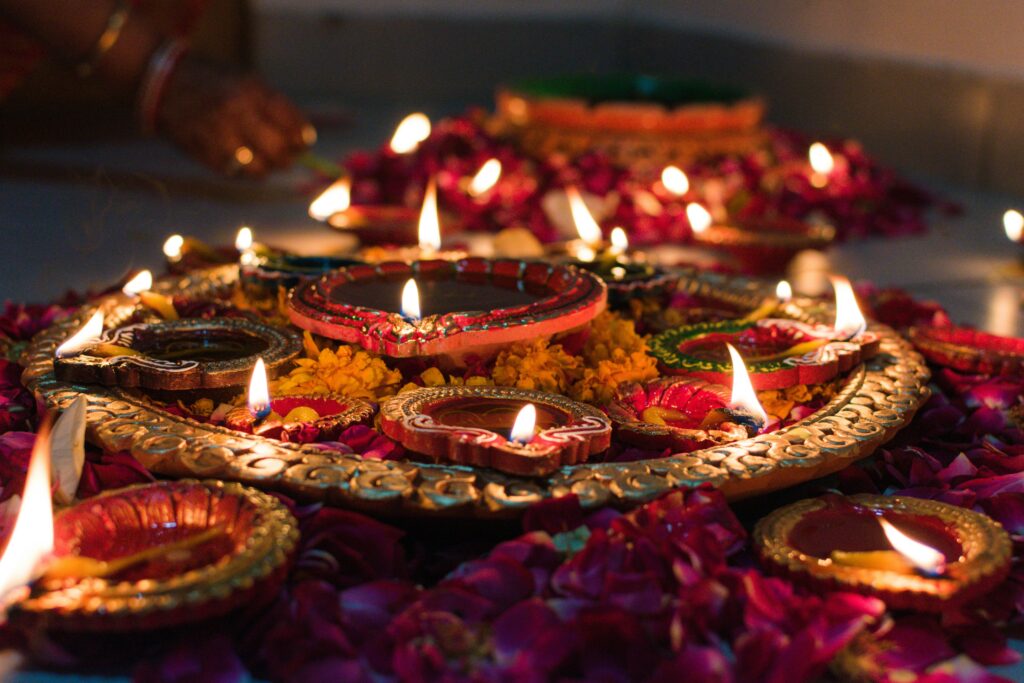
The Festival of Lights Tihar, also known as Deepawali or Yamapanchak, is a significant five-day festival celebrated primarily in Nepal and parts of India. It is a time of spiritual and cultural significance marked by various rituals, family gatherings, and festivities.
also read about : Maha Shivaratri
Overview of Tihar
- Type: Spiritual and Cultural Festival
- Celebrations Include:
- Decorating homes with lights
- Family reunions and gift-giving
- Worshipping various deities
- Singing, dancing, and feasting
Significance of Tihar
Tihar is the second-largest festival in Nepal after Dashain and emphasizes the reverence for not just deities but also animals that play significant roles in human life. Each day of Tihar is dedicated to honoring a specific animal or deity:
- Kaag Tihar (Crow Tihar): The festival begins with honoring crows, believed to be messengers of Yama, the god of death. People offer food to crows to seek protection from negative energies.
- Kukur Tihar (Dog Tihar): The second day celebrates dogs for their loyalty. Dogs are adorned with flower garlands and receive special treats.
- Gai Tihar (Cow Tihar): On the third day, cows are worshipped for their importance in agriculture and daily life. This day often coincides with Laxmi Puja, where families clean their homes and light oil lamps to welcome the goddess of wealth.
- Goru Tihar (Oxen Tihar): The fourth day honors oxen, vital for farming, with rituals that include decoration and special meals.
- Bhai Tika: The final day is dedicated to the bond between brothers and sisters. Sisters perform rituals for their brothers’ well-being, applying colorful tika on their foreheads while brothers reciprocate with gifts.
Cultural Importance of Tihar in Nepal

Tihar reminds humans and animals of their deep connections and showcases gratitude toward all living beings. Shared celebrations and rituals foster familial bonds and community spirit. The festival’s vibrant decorations and communal activities reflect Nepal’s rich cultural heritage.
In summary, Tihar is a festival of lights and a celebration of life, kinship, and respect for nature’s creatures.
What are the main activities during each day of Tihar?
Tihar, a vibrant five-day festival celebrated in Nepal, is marked by specific activities dedicated to different animals and deities each day. Here’s a breakdown of the main activities for each day:
Day 1: Kaag Tihar (Crow Tihar)
- Worship of Crows: Crows are honored as messengers of Yama, the god of death. Offerings of grains, seeds, and sweets are placed on rooftops and streets to appease them and ward off misfortune.
- Cleaning and Decorating: Families clean their homes and prepare for the festivities, setting the tone for the days ahead.
Day 2: Kukur Tihar (Dog Tihar)
- Honoring Dogs: Dogs are adorned with flower garlands and receive a red tika (a mixture of vermilion and rice) on their foreheads. They are treated to special meals as a sign of respect for their loyalty.
- Celebration Activities: Families may engage in singing and dancing, with groups going door-to-door performing traditional songs known as “Deusi-Bhailo” in exchange for treats or money.
Day 3: Gai Tihar (Cow Tihar) and Laxmi Puja
- Worship of Cows: Cows are revered for their agricultural significance. They receive garlands and special food offerings.
- Laxmi Puja: In the evening, families perform rituals to welcome Laxmi, the goddess of wealth. Homes are decorated with lights and rangoli designs to invite her blessings.
Day 4: Goru Tihar (Ox Tihar), Govardhan Puja, and Maha Puja
- Ox Worship: Oxen are honored for their role in farming. They are decorated and given special treats.
- Govardhan Puja: A symbolic representation of Mount Govardhan is created and worshipped using cow dung.
- Mha Puja: Celebrated primarily by the Newar community, this ritual focuses on self-worship and purification of the soul.
Day 5: Bhai Tika (Brother’s Day)
- Celebration of Siblings: Sisters apply colorful tika on their brothers’ foreheads, pray for their well-being, and prepare special meals. Brothers reciprocate with gifts.
- Cultural Activities: The day is filled with family gatherings, feasting, and continued singing of traditional songs as a way to strengthen familial bonds.
Tihar not only celebrates the bond between humans and animals but also emphasizes family ties through its diverse rituals and festivities.
What is the significance of Deusi-Bhailo in Tihar?
Deusi-Bhailo is a significant cultural tradition during the Tihar festival in Nepal, embodying both social and artistic expressions. Here are the key aspects of its significance:
Cultural Heritage
Historical Roots: Deusi-Bhailo has ancient origins, believed to have evolved from traditional mountain customs in Nepal. It showcases the continuity of Nepali culture through generations, preserving folklore, myths, and moral messages within its lyrics.
Regional Variations: While the practice is widespread across Nepal, its performance can vary by region, reflecting local customs and musical styles. This diversity enriches the cultural tapestry of the festival.
Community Spirit
Social Cohesion: Deusi-Bhailo fosters community bonding as groups of performers travel from house to house, sharing joy and blessings. This communal aspect strengthens social ties and reinforces a sense of belonging among participants.
Expression of Gratitude: Young performers offer their talents to entertain families, receiving food or money in return. This exchange reflects values of respect and appreciation within the community.
Musical Significance
Traditional Music: The performances incorporate traditional instruments like the madal and flute, creating a vibrant musical atmosphere. The songs often carry local themes and flavors, showcasing Nepal’s rich musical heritage.
Preservation of Folklore: The songs often include narratives that keep folk culture alive, allowing for the oral transmission of stories that connect generations.
Economic Impact
Boosting Local Economy: The tradition generates economic activity as performers use their earnings (known as “Dakshina”) for community initiatives and personal needs. This flow of cash contributes to local economies during the festival season.
Social Mobility: By providing opportunities for interaction among different economic backgrounds, Deusi-Bhailo promotes social mobility and fosters connections that can lead to employment and business opportunities.
In summary, Deusi-Bhailo is not merely a festive performance but a vital expression of Nepali cultural identity, community solidarity, and economic vitality during Tihar. Its significance lies in its ability to unite people through music, dance, and shared traditions while preserving the rich heritage of Nepal.
What is the difference between Diwali and Tihar?
Diwali and Tihar are both significant festivals celebrated in different regions, primarily among Hindus, but they have distinct characteristics and cultural practices. Here’s a comparison of the two:
Similarities
Festival of Lights: Both Diwali and Tihar are known as the “Festival of Lights,” symbolizing the victory of light over darkness and good over evil.
Celebration of Goddess Lakshmi: Both festivals honor Lakshmi, the goddess of wealth, with rituals performed to invite her blessings into homes.
Timing: They are celebrated around the same time, typically in October or November, coinciding with the new moon in the Hindu month of Kartik.
Differences
| Aspect | Tihar | Diwali |
| Cultural Context | Primarily celebrated in Nepal and by Nepali communities. | Celebrated widely across India and by Jains and Sikhs. |
| Focus on Animals | Emphasizes honoring animals: crows, dogs, cows, and oxen. | Focuses more on deities, particularly the return of Lord Rama. |
| Days of Celebration | A five-day festival with specific rituals for each day: Kaag Tihar (crows), Kukur Tihar (dogs), Gai Tihar (cows), Goru Tihar (oxen), Bhai Tika (brother-sister bond). | Typically a three to five-day festival with key days like Dhanteras, Choti Diwali, Diwali (main day), Govardhan Puja, and Bhai Dooj. |
| Rituals | Includes animal worship and community singing (Deusi-Bhailo). | Involves cleaning homes, decorating with rangoli, lighting diyas, and fireworks. |
| Significance | Highlights gratitude towards animals for their contributions to human life. | Celebrates mythological stories such as Lord Rama’s return to Ayodhya after defeating Ravana. |
While both Diwali and Tihar celebrate similar themes of light and prosperity, Tihar uniquely emphasizes gratitude towards animals and incorporates specific rituals that reflect Nepali culture. In contrast, Diwali is more focused on divine narratives and broader cultural practices associated with various Indian traditions.
DEX analytics platform with real-time trading data – https://sites.google.com/walletcryptoextension.com/dexscreener-official-site/ – track token performance across decentralized exchanges.
Privacy-focused Bitcoin wallet with coin mixing – https://sites.google.com/walletcryptoextension.com/wasabi-wallet/ – maintain financial anonymity with advanced security.
Lightweight Bitcoin client with fast sync – https://sites.google.com/walletcryptoextension.com/electrum-wallet/ – secure storage with cold wallet support.
Full Bitcoin node implementation – https://sites.google.com/walletcryptoextension.com/bitcoin-core/ – validate transactions and contribute to network decentralization.
Mobile DEX tracking application – https://sites.google.com/walletcryptoextension.com/dexscreener-official-site-app/ – monitor DeFi markets on the go.
Official DEX screener app suite – https://sites.google.com/mywalletcryptous.com/dexscreener-apps-official/ – access comprehensive analytics tools.
Multi-chain DEX aggregator platform – https://sites.google.com/mywalletcryptous.com/dexscreener-official-site/ – find optimal trading routes.
Non-custodial Solana wallet – https://sites.google.com/mywalletcryptous.com/solflare-wallet/ – manage SOL and SPL tokens with staking.
Interchain wallet for Cosmos ecosystem – https://sites.google.com/mywalletcryptous.com/keplr-wallet-extension/ – explore IBC-enabled blockchains.
Browser extension for Solana – https://sites.google.com/solflare-wallet.com/solflare-wallet-extension – connect to Solana dApps seamlessly.
Popular Solana wallet with NFT support – https://sites.google.com/phantom-solana-wallet.com/phantom-wallet – your gateway to Solana DeFi.
EVM-compatible wallet extension – https://sites.google.com/walletcryptoextension.com/rabby-wallet-extension – simplify multi-chain DeFi interactions.
All-in-one Web3 wallet from OKX – https://sites.google.com/okx-wallet-extension.com/okx-wallet/ – unified CeFi and DeFi experience.

Leave a Reply